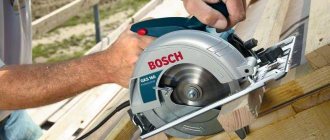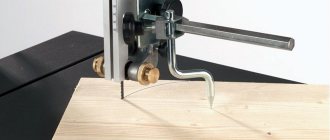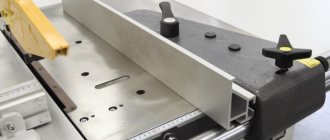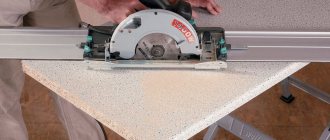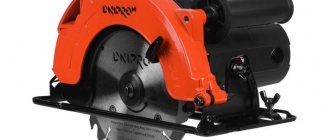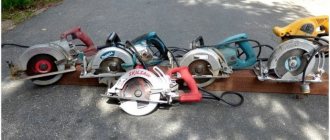A circular saw. Concept
A circular saw is a special electric tool that allows you to quickly and smoothly cut wood products, plywood, laminate and various boards.
There are household and professional models. The former can function with pauses. Their engine needs breaks of 15-20 minutes. They cannot withstand significant loads.
The latter have more powerful engines. They can work intensively for a very long time. Therefore, they are usually used in production.
For personal use, household modifications are used. And keeping professional versions is unprofitable.
The level of work and its types are determined by the frame of this tool.
Circular saw miter tool
One option to ensure an even perpendicular cut with a circular saw is to make such a simple device. It is not difficult to make and can be done in a couple of hours. As materials, it is quite possible to use scraps of boards and plywood, which are usually found in a carpentry workshop.
The guides ensure straight feed of the saw, and the side stops ensure good fixation of the workpiece.
The quality of the cut in this case will be comparable to a cut with a miter saw.
General view of the trimming device and the trimming process:
Materials and assembly of guides:
Marking and fixing the position of the guides on the platform:
Trimming test results:
Animation of the trimming process:
Video from the author of this device for mitering with a circular saw:
Based on materials from the Log Lab channel (Youtube)
About the elements of the frame
The attachments for a circular saw are different. The main one is the bed. If the power of the saw is insignificant (no more than 1.2 kW), such a frame is not difficult to build yourself. Its length is affected by the length of the material going for cutting.
A Bosch electric drill is suitable for the drive; its parameter is 0.85 kW. It is mounted under the stove using a special bracket.
The accuracy and evenness of the cut is better when the workpiece rests entirely on the table surface. And if the table has too large parameters, it will fill the entire work area. Here you need an average value. The height is selected according to your height to make it more convenient to work.
Making a table
When you need to assemble accessories for a circular saw with your own hands, the first step is to create a frame. It consists of a base and a table top.
The design of the second element is influenced by the structure of the working disk fastener.
The process of creating a key fixture for a circular saw takes place in several stages. They are outlined below:
- A functional table (table top) is created from a plywood sheet. Work proceeds according to the selected parameters. Markings are made on the sheet using a pencil along a ruler. The sheet is cut with a jigsaw. The edges are processed with a router. The created workpiece is polished.
- Marks for the saw are indicated on the bottom plane of the tabletop. The completed workpiece is turned over. A saw without a blade is placed on the intended area. The parameters of the sole are indicated.
- Using a router, an 8-10 mm opening is created in this material according to the designations of the landing area.
- Trying on a saw. If necessary, the parameters are adjusted. Then the areas of its fasteners and the slot for its disk are designated. If the material will be cut at different angles, this must be taken into account when marking the slot. She will receive a section in the shape of a trapezoid. The top will rush down.
- The pencil marks the stiffening ribs. The legs will join them later.
- Work on the stiffeners. To create them, boards 5 x 10 cm are used. They are placed around the perimeter at a distance of 7-10 cm from the extreme side of the table. The board is applied to the tabletop. Circled on both sides. Its main line is marked along the ruler. The positions of the screws are marked on it. They are as follows: 5 cm - from the extreme side of each of the existing ribs. In this case, a distance of 15-20 cm is maintained along the entire length of the rib. Through holes are drilled according to the created markings.
- Longitudinal stiffening ribs are installed. To do this, boards are marked and sawn. They are glued to the tabletop. They are tightened with clamps.
- The side stiffeners are marked. The boards are sawn and glued as in step 7.
- The clamps are held in place. The structure is pulled using self-tapping screws through the created holes, which are pre-drilled from the outside. This way the heads of the screws will be completely sunk into the table top.
- The stiffening ribs are tightened together with two 5 cm self-tapping screws. The tightening occurs from all sides. Clamps are removed. It turns out to be a tabletop.
Do-it-yourself accessories for a circular saw – Machine tools, welding, metalworking
How to make a circular saw with your own hands from a hand-held circular saw
If a person lives in a private home or has a garden plot, then having a stationary circular saw in the home craftsman’s arsenal is not only better, but sometimes even necessary. The simplest homemade guide bar for a circular saw or DIY.
Unfortunately, the price of an industrially made standard of such a saw does not correspond to the frequency of its home use, and for some Russians it is simply not affordable. At the same time, making a “circular” with your own hands is quite simple, using the drive of a sewing machine or an ordinary electric drill. Selecting a saw blade for a circular saw blade. The disc is needed for Selecting a 190mm disc for.
But the quality of work performed and the range of operations performed depend almost entirely on the circular saw .
Bed design
The simplest circular saw frame, the drive power of which does not exceed 0.8...12 kilowatts, is quite easy to make with your own hands from thick plywood and wooden blocks. Below are several ways to make a table from a hand-held circular saw.
For the drive, you can use an electric drill “BOSCH GSB 19-2” (power 0.85 kilowatts) or “DWT SBM-1050” (power 1.05 kilowatts), which is attached to under the stove using a special bracket. The length of the bed will depend on the length of the material being cut. For the table, you must purchase bakelite plywood with a thickness of at least 50.0 millimeters. DIY table for a circular saw.
DIY guide for a hand-held circular saw. Of course, a wooden bed is not suitable for professional work, but in order to unravel boards and quickly saw through bars, such a homemade design is quite sufficient.
In general, the bed will consist of a base and a tabletop (desktop).
Of course, when manually making a circular saw , you must strive to simplify the design as much as possible.
The design of the work table will primarily be determined by the design of the cutting blade mounting unit. DIY guide bar for a hand-held circular saw.
Homemade circular devices use either a circular disk mounted directly in the chuck of an electric drill, or (more preferably) a two-support shaft driven into rotation by an electric motor through a belt drive.
Making a countertop
At the first stage of making a frame with a wooden tabletop with your own hands, the existing sheet of plywood is placed in accordance with the existing sketch or drawing. In order to reduce the number of cuts, markings are carried out from the edges of the sheet. DIY accessories for circular saws. The tool used is a fine-toothed hacksaw or a jigsaw.
A few simple accessories for a hand-held circular saw. Part 1
These simple and very useful devices
for
a hand-held
circular
saw
- rip fence,
device
.
Do-it-yourself miter box or miter cutter for a hand-held circular saw
Group VK This is an easy-to-manufacture device
, for sawing at different angles, c.
A slot for the disk is marked on the underside of the sawn piece. The cut can be made with a finger cutter, securing it with your own hands in the chuck of an electric drill. DIY circular table made from a hand-held circular saw. DIY table for a circular saw.
In order to maintain the straightness of the cut edges, a simple homemade copier made from two metal corners is attached to the tabletop with clamps. Further work depends on the mechanism for attaching the circular
saws.
The easiest way is to install it manually on two bearing supports, and drive it through a belt drive from a separate electric motor or from an electric drill.
To add additional rigidity to the tabletop, it is advisable to attach stiffening ribs along its edges, which can be made from bars or aluminum corners. The stiffeners are fastened to the table using self-tapping screws.
To give greater strength to the entire structure, an additional layer of epoxy glue can be applied to the joint, which will fix the block to the tabletop along the entire plane of the joint.
The distance from the edge of the tabletop to the block should be 2.0...4.0 centimeters.
After this, in accordance with the selected drive design, the circular disk support assembly is attached.
For reliable fastening, it is better to fix the bearing housings to the frame using a screw, threaded connection.
In this case, the countersunk screw heads are located on the upper plane of the tabletop and should not protrude above its plane. The upper working surface of the desktop should be coated with wear-resistant varnish and polished.
For greater safety when working with a homemade device, it is advisable to install a swinging protective cover over the cutting edge of the disk.
Base design
For safe operation of a homemade circular saw, the table must be installed on a sufficiently rigid and durable base. To make it manually, the master’s imagination is given complete freedom. The base can be made in the form of a wooden base, but it is better to weld it from a corner (such as an aquarium frame) in accordance with the size of the tabletop.
Some manufacturing nuances
The main parameter that determines the design of a homemade “circular saw” is the thickness of the boards being cut. A circular saw is a circular hand saw for sawing boards, like.
For household work with your own hands, it is usually not necessary to saw wood thicker than 15.0 ... 20.0 millimeters.
To change the depth of the cut, you can use and/or make a special mechanism for lifting the disk, but this will significantly complicate the design of the homemade product.
Using a belt drive, you can change the speed with your own hands.
If you plan to use an electric drill as a drive, then preference should be given to models with variable chuck rotation speed, then use a DIY circular saw like this
, it will be a pleasure.
Conclusion
Despite the primitiveness of the described design, it will significantly facilitate DIY homework, from carpentry operations with boards to cross-cutting thick branches cut from garden trees.
DIY circular machine: possible design options, description of the manufacturing process
Surely most men are familiar with a hand-held circular saw. It's a useful thing, no one argues. However, it is not suitable for processing large quantities of wood. Only a circular machine can replace it. Having such a device on the farm, you can easily saw the required amount of material, give it any shape, cut blanks at any angle.
Circular machine: device and application
So, circular machines are:
- Manual (regular hand saw).
- Stationary,
which are divided into:
- household (maximum cut depth 4-5 cm),
- desktop (5-5.5 cm),
- on the bed (6-14 cm).
They are used in private households, as well as in small and medium-sized woodworking businesses. The design of such machines may differ in the materials from which they are made and in power.
Typically, the frame is made of metal and can be cast or welded , that is, collapsible. The cast frame is placed on a concrete pad reinforced with reinforcement and, accordingly, it is difficult to move it anywhere. Collapsible, on the contrary, differs, as you understand, in mobility and low weight compared to cast.
A working surface is installed on the frame - a tabletop, which is made of sheet aluminum, steel or cast iron. It must be equipped with guide rulers and a slot for saw blades.
For all this to work, you need a saw shaft on which a saw blade and an electric motor are mounted. In addition, large machines are equipped with a wood feeding mechanism. The circular saw can also be equipped with a riving knife, which prevents the sawn halves from closing together, and a protective casing , which prevents sawdust from flying in different directions.
We briefly described the structure of a factory circular saw. The cost of such devices is quite high. Therefore, sometimes the question arises: is it possible to assemble a machine to suit your needs with your own hands? Of course you can.
DIY circular machine: options
Before you move on to making a homemade machine, you need to decide what volume of work it will be designed for? If you are building something and will constantly use it, then the machine should be larger, more stable with a large tabletop . Well, if a circular saw is required periodically or for processing small-sized parts, then there is no need to make the machine large.
The simplest option is a machine made from a hand saw drilled to the tabletop. Make a cut with the same saw and get a hole for the disk. You cut out a block of the required length, attach it, and the ruler is ready. Attach the tabletop to the base so that the saw body is at the bottom, and the ruler and disk are on top. And that's it, you can start working.
Creating legs
Assembling a full-fledged device for a circular saw is not limited to these stages.
For the legs you will need a board 5 x 10 cm. Their height is 1-1.2 m.
The board is cut along the longitudinal vector. In this case, a slight angle is maintained on one side.
The legs are fitted to the tabletop. During installation they should be slightly apart.
They are attached outside the stiffeners. Fastening method: bolted. To increase their stability, you will need ties. They require a 5 x 5 cm block.
The hand saw is placed in the previously created groove from the lower area of the tabletop. The sole is fixed with bolts. The disc is placed in the slot.
The table is varnished in 3-4 layers. This is a measure against moisture.
Trimming issue
The miter saw attachment is especially useful when you need quality cross cuts.
Such a device can be made independently using the proposed technology:
- The base is being assembled. Two parallel strips of 2.5 x 5 cm are glued to the upper zone of plywood with parameters 1.8 x 30 x 122 cm. They are attached with screws.
- Corners are attached to them (their material is aluminum). Fastening method: countersunk screws. The mounting angle is 90 degrees. The fastening occurs parallel at a distance identical to the width of the saw base.
- The tool is adjusted to cut the planks to a shallow depth at the base.
- The device is fixed with clamps. A workpiece is placed under the corners. The cut is made.
If the saw does not work well, this area can be coated with paraffin, but with a thin layer.
How to make a device with your own hands
The cutting device is made for a specific model of power tool. On your circular saw, measure the distance from the engine to the bottom plane of the sole and subtract 5 mm. The result obtained is the height of the guide stop.
Removing the required dimensions of the circular saw.
Prepare a plywood base with right angles and wooden slats with parallel edges according to the dimensions.
Blanks for assembling a device for cross-cutting with a circular saw.
Measure the distance from the cutting blade to the edge of the sole.
Add an allowance of 6–10 mm and install a guide rail at this distance from the right end of the plywood. Secure the plank with countersunk screws, ensuring its strictly perpendicular position.
Screw the stop block on the back side and fix the device on the workbench.
Cut the plywood to the final width with a circular saw, creating a reference edge for precise positioning of the jig along the markings.
Draw a template for the cam clamp cam on paper.
Drawing of an eccentric clamp.
Mark the piece on 10mm plywood and use an awl to mark the center of the drill hole for the bolt.
Cut the workpiece with a jigsaw.
Make a washer with a diameter of 50 mm from the same plywood using a ballerina extendable wood drill.
Sand the workpieces and select an M6 or M8 furniture bolt with a mustache (or with a square headrest), a handwheel nut, a washer and a bushing. The latter can be made from a tube of suitable diameter. The length of the sleeve is the total thickness of the base, lever and plywood washer.
Ready-made plywood eccentric.
Make holes in the base with a drill according to the diameter of the bushing, which serve to rearrange the eccentric clamp according to the width of the board being cut.
Hole drilling diagram.
Assemble the eccentric mechanism: insert a bolt with a sleeve on top, and install a wooden washer, the cam itself and a steel washer from below. Tighten the parts with a nut.
Stick a strip of sandpaper on the inside of the stop to prevent slipping when the eccentric is locked, which can happen when the device is fastened to a smoothly planed workpiece.
The clamping system of this device has a stroke that ensures fastening on boards with a spread of approximately 10 mm in width. If you need to cut or trim pieces of a different size, simply place a wooden block in front of the stop beam.
An example of using a device for cross-cutting a board of smaller width with a hand-held circular saw.
If desired, the potential of the considered device can be expanded by adding a cutting angle of 45°. To do this, you will need to slightly increase the dimensions of the support platform and install a second thrust block at a given angle.
Question about long cuts
Creating an attachment for a hand-held circular saw that will help make long cuts is important for many home craftsmen. It greatly simplifies the work.
It's easy to do. Fiberboard is taken. A sample is cut from this material. It is identical to the distance from the outer side of the tool base to the outermost part of the disk from the inside.
When cutting, you need to rely on the length of the tool base.
The edge of the sample is aligned with the cut mark on the workpiece. A straight piece is applied to the second side. This is the guide. It is fixed with a clamp.
On the second marking, this operation is duplicated, but on the opposite side of the workpiece.
To create a template, it is optimal to use a router or jigsaw.
Solving the problem with chips
If the disc chips while working, you cannot do without the following device for a hand-held circular saw, assembled with your own hands.
Technology:
- The hardboard element is cut out. Its density is 6 mm. When cutting, you need to focus on the width of the tool base.
- The disk is retracted. The protective cover rises. The result of step 1 is attached to the base with double-sided tape. After this, the saw starts. The disc fits smoothly into the hardboard. This results in zero gap in operation.
Sawing should be done with little impact on the created base.
DIY circular
In the household, a circular saw always comes in handy. Major repairs are a costly and troublesome task. Not everyone can afford to buy expensive tools for processing wooden materials.
A DIY circular saw allows you to carry out safe work and speed up the construction process.
A saw made by yourself has a number of advantages, such as reliability, efficiency and sharpening for immediate needs.
A circular saw
Purpose of a circular saw
Before you begin assembling the machine, you need to clearly define its purpose. For preparing firewood and simply cutting large pieces of wood, a firmly fixed table with a slot for a saw is sufficient. This type is common in villages and rural areas; the machines are not safe and have increased functionality.
For a more varied range of carpentry jobs, you will need a better option. The circular machine must be equipped with a coordinate table with special guides, this allows you to change the degree. The manufacture of small-sized products requires increased safety. Speed control is installed and discs can be changed.
DIY circular in action
Design features of a circular machine
Circulars of any fixed type consist of main parts.
- Table for connecting mechanisms. An assembly combined with higher power engines is preferable to a table made entirely of metal. The surface of the table must be made level with your own hands, for a higher quality product at the end.
- The engine in most cases is used from what is in stock. Electric motors designed for long-term operation from the network will be preferable to commutator drives.
- The shaft is the most critical component of the circular. Finished products are used most often; in other cases, the assembly is made on a lathe. It is important to calculate the mounting holes and eliminate runout.
You can use a washing machine engine for a circular saw. Making a table for a circular saw
When making a machine with your own hands, you should pay special attention to safety. The main surface of the saw blade should be covered with a protective cover. The moving parts of the drive and motors must be covered. The emergency stop button is built into the electric drive circuit and has a convenient location.
Manual device from an angle grinder
A lot of work is done with the popular grinder tool. This tool will make a hand-made circular saw that is indispensable for households.
It is enough to make a sliding stop from available material. The design assumes the presence of two small sections of corners that are located parallel to the disk.
The connection is made using bolts, the gap is adjusted with supplied washers.
The band clamp is installed so that the screw location is at the bottom. Next, a strip of metal with a hole is attached; in another case, the structure may be uniform, but this way the thickness of the metal is lost.
The next step is to cut holes in the body through which the handle is attached to perform basic work. A hand-made handle is a horn or bracket, based on a metal rod or pipe.
It is also worth considering the riveting; if the ends are relaxed, the handle may bend during mechanical action on it.
Mini table saw
A stationary machine is more functional and safer to use. A homemade table-type circular saw is made at home in the same way as a hand saw, with the addition of some elements. A homemade circular saw with your own hands will require prepared drawings.
The process involves using a 2 cm pipe, the metal is bent in a U shape. The mount is installed with bolts to the table, the lower ends are bent in the direction of work. Additional stability is obtained by installing a lever with a jumper welded together in the shape of the letter “T”.
DIY mini circular
A table for a DIY table saw can be used as a cutting machine. The cut cannot reach more than 8 cm, so larger jobs will require the use of a larger machine.
Stationary machine with your own hands
To perform everyday or one-time tasks, a hand-made circular saw is quite suitable. Small-volume sawing work does not imply heavy loads on the disk drive.
The compact tool has small dimensions, which makes it possible to put it away after finishing work in a certain place.
An experienced carpenter will need to make a large stationary type circular saw.
Making a stationary circular saw with your own hands will require precision and literacy from the master. Drawings presented in many types of literature will help in manufacturing. It is worthwhile to treat every component of the unit competently and carefully, because the circular machine is used at high speeds with a cutting tool.
Circulation table
Assembly diagram of a table for a circular saw. Diagram of the design of a table for a circular saw
The main condition for making a table is the selected material.
It is recommended to use a solid steel sheet, duralumin or silumin alloy. Materials such as moisture-resistant plywood, plexiglass and textolite require processing and installation on top of a galvanized sheet.
The use of any material in manufacturing must meet the main conditions:
- increased vibration resistance;
- sagging with a load exceeding 50-60 kg is unacceptable;
- the presence of a perfectly flat surface.
In cases where the conditions are not met, a DIY circular saw may stop due to a jammed disk or a broken drive. The consequences can be different, from a damaged part to injury to a person.
https://www.youtube.com/watch?v=iPolVbOydRs
There are several options for making a circular table. Stationary tables can be sawed or made from two parts. The circular saw blade should protrude no more than a third of its diameter.
Saw blade
Saw blade
The design of a DIY circular saw must contain a saw blade. The working surface of the disk is set to one third of the total diameter. For example, with a diameter of 210 mm, the disk should protrude 70 mm from the table. Parts with greater thickness will require a powerful motor, from 1 kW. A miniature circular saw will not cope with such tasks.
The splitting knife installed on some models serves to prevent short circuits and jamming during operation. It is located at the back a few millimeters from the teeth of the saw blade. The device may also be needed when making a circular saw with your own hands.
Adjustable side support
Any type of work will require a stop. The side support is made of a block of dense wood. In other cases, it is possible to make it from a metal corner. The arrangement should be slightly longer than the table structure. The stop is installed using bolts. The template is installed between the table and the cutter for precise installation and better settings.
Shaft
Homemade shaft
The most important part of the design is the shaft mounted on the circular saw. A self-made shaft for a circular saw can damage the structure and cause injury.
The reason for this is runout, which cannot be avoided when making a shaft using artisanal methods. The manufacture of the shaft should be entrusted to a specialist with good turning equipment. You should remember that there is a cutter that needs a seat.
The holes must be symmetrically machined and machined.
Finished shafts are sold in specialized markets. Preference should be given to parts with a self-aligning bearing. Otherwise, the conventional mechanism may soon render the circular machine unusable.
Broadcast
There are several types of gears that can be used in the design of a DIY circular saw:
- V-belt transmission;
- mechanism consisting of gears.
The preferred option is to use a belt drive. Using a mechanism with gears can lead to jamming if a foreign body enters and injury to the worker. When choosing the pulley diameter, the maximum number of revolutions of the saw blade is taken into account.
Motor
Electric motor for circular saw
In most cases, homemade machines are equipped with an engine from an old washing machine. The main features are increased service life and efficiency.
The speed of such engines is not high, which makes working on a circular saw assembled with your own hands safer, longer, and has a positive effect on the result. The use of a special three-phase motor implies the presence of a 380 Volt network.
If one is not available, you will have to use a starting and running capacitor, which leads to additional costs.
Circular saw from a grinder or circular saw
When working with small workpieces, it is enough to get by with a small circular saw. A circular saw is made with your own hands from available power tools; you will need a grinder or a circular saw.
There are many options for stationary use of improvised tools. It is enough to secure the device from the bottom of the table to access the material to the disk.
The height is adjustable depending on the workpiece, but for safety reasons should not exceed one third of the size of the saw blade.
This installation option is not available for the switch; it is necessary to modify the device for convenient operation.
A fairly common option is to use a frame on guides. The simple design allows you to use the tool to work at any angle. It consists of two parallel metal pipes or angles on which the saw is mounted.
A hand-made circular saw makes the work you do faster and more economical.
Such a device will be needed during major repairs and other actions related to cutting wood.
The simplicity of the design, the possibility of using scrap materials, makes the cost almost zero, and making it yourself allows you to add the necessary functionality for the job.
, please select a piece of text and press Ctrl+Enter.
Tenoning device
A tenon-cutting device for a circular saw increases the efficiency and accuracy of the production of tenon and groove joints. They are involved in the assembly of various carpentry products: furniture, doors, frames, frames, etc.
Thanks to this device:
- The workpieces are positioned without distortion.
- Operations are repeated scrupulously.
- The final result is of high quality.
You can purchase such a device or make it yourself. Experts recommend the first option. This is a full guarantee of achieving excellent results.
The following models are often purchased: Felisatti FTJ and Festool VS 600 GE.
This is a reliable and proven technique.
Sharpening question
The circular saw needs to be sharpened when the following symptoms appear:
- It becomes harder to work with her.
- It leaves black marks on the material.
- There is a nasty smell and smoke.
Ideally, it should be sharpened on a professional machine. If you don't have one, you'll need a tool for sharpening circular saws.
Required set for work:
- Vise.
- File with flat functional side.
- Beam.
You should work with gloves.
Sharpening stages:
- Rigid fixation of the disc. It is removed from the saw and secured in a vice. In this case, wooden dies are used. You can leave it in the saw, but stick a block between its teeth. The block rests on some surface.
- The initial tooth is marked.
- The back of the tooth is processed with a file. They need to swipe it several times. The effort is small. Each tooth is sharpened in turn. The movements are uniform, the number of strokes with the file is the same.
- The front parts of the teeth are processed. The principle is the same.
The tips of the teeth should be perpendicular to the surface of the disc.
All teeth are then inspected for defects. The edges should not be shiny. If so, they are smoothly filed with a file.
After this, the disk is checked in action. It fits into the saw. It turns on. A test block is used. If the saw is light, smooth and quiet, then the sharpening is of high quality.
Otherwise, you need to check the height of the teeth. To align them, you need to bring the marker to the working edge. Then the disk must go through the entire revolution in the other direction from the rotation. A mark remains on all teeth. You can use it to adjust their height. The highest teeth are carefully processed with a file.
Do-it-yourself accessories for a circular saw - Metalworker's Handbook
A hand-held electric circular saw, which is simply called a circular saw, is a convenient tool for cutting and cutting lumber.
It usually comes complete with devices that help the master in his work.
But the same devices can be made or improved with your own hands. And work experience will sooner or later lead to the appearance of completely homemade devices (as they are called), which, despite their simplicity, can greatly facilitate sawing and save time.
Rip fence
A regular rip fence for a circular saw is a good example of how a small addition can make a big difference. Almost every hand-held circular saw is equipped with a rip fence for longitudinal cutting of a given width. This is a really useful device.
The standard stop has one drawback. For safety reasons, it is set to values that allow it to be used to make cuts less than 20–25 mm wide.
This is done so that the stop does not interfere with the movement of the saw guard.
But it is enough to attach a wooden block with self-tapping screws to the parallel strip of the standard stop - and its capabilities will increase, while the minimum cutting width will not be limited in any way.
Note! We must remember about safety - when making cuts of less than 15 mm, the block does not allow the protective casing to cover the saw blade.
Stop for cross and corner cuts
The crosscut jig is also often used. With its help, boards are cut quickly and accurately at an angle of 90°. This type of stop is also used for cutting boards.
Its base is a sheet of plywood 10 mm thick. A guide block or rail with a height of at least 20 mm is fixed to it with glue or self-tapping screws.
A stop is attached to the bottom side of the base, perpendicular to the guide and made from the same block.
The excess part of the base (from the guide to the saw blade) is cut off. Since this distance is different for each model of manual circular saw, the device is always made individually. It is usually secured to the material being processed with clamps.
Advanced craftsmen make their fastening devices from wooden washers, one of which has the shape of an eccentric. The clamping is carried out by a wing nut on the screw. This clamping device allows you to very quickly secure the fence to lumber of different widths.
If you install the same block on the other side of the guide, but fixed at an angle of 45° to the first one, and then cut off part of the base with a saw at 45°, you will get a universal angular stop for cuts at both 45° and 90°.
A more universal design of the angle stop will be obtained if the bar rotates. And you can monitor compliance with the angle using a protractor attached to the top.
It should be noted that making a protractor for a circular saw with your own hands is a more difficult task.
Saddle stop
If you have to saw a lot of identical bars with a circular saw, then it’s worth spending time making a simple saddle stop. Its use will more than return the spent minutes. The saddle stop works especially effectively when cutting thick beams, for which the disk requires two cuts from different sides.
The saddle stop is U-shaped. The base is a board 25 mm thick, its width is exactly equal to the thickness of the sawn timber.
The side surfaces of 10 mm plywood are attached to the base. The width of the sidewalls must be greater than the width of the beam in order to provide support for the circular saw platform until the saw blade comes into contact with the beam.
The saddle is put on the beam at a distance from the cut marking, corresponding to the working distance to the saw blade, and is pressed through the sidewalls to the beam with clamps.
Using the side as a support for the saw platform, cutting is carried out. If the thickness of the timber is such that one cut is not enough, then it is turned over and another cut is made.
The position of the stop does not change in any way.
Guide rail
For cutting large and long sheet lumber on the table, a long DIY circular saw guide bar will be useful.
The basis in this case is an (8–10 mm) plywood strip with a length exceeding the dimensions of the sheet being cut. The tire itself can be wooden (a block 15–20 mm thick) or metal from a U-shaped profile. The tire is attached to the base with glue or screws.
On one side of it there should be a narrow edge of the base, sufficient for fastening to the sheet with clamps. On the other side, the first cut is made with a saw along the base. After this, the edge of the base will exactly coincide with the passage of the circular disk.
When working, it is combined with the markings on the sheet, the stop is secured and the sheet is sawed.
Edge stop
This is already a rather complex device that requires time and precision in manufacturing. It allows you to cut parallel to the edge of the material being cut. It will be useful to make a drawing of it before starting work so as not to miss the dimensions.
Actually, such a stop is included in the circular saw kit, but its short length does not always ensure an even cut. The large size and the desired strength require the base of the stop to be made of plywood with a thickness of at least 15 mm. You can also make a thrust bar from it.
Stages of manufacturing the stop:
- longitudinal grooves for dowels are made at the base;
- hardwood dowels are mounted on a stop bar;
- Another through groove is made between the longitudinal grooves to secure the thrust bar during operation;
- a hole is cut in the base for a circular saw blade;
- On the sides of the base, restrictive strips are placed for installing the circular and clamps are provided to secure it securely.
When installing the stop on the material being processed, the stop bar moves in the grooves of the base to the required distance and is secured through the through slot with a clamping wing screw. In order not to have to worry about the ruler every time, you can attach it (or a piece of tape measure) to the base of the stop along the guide grooves.
Useful tricks and tips
There are such small devices that it is shameful to even consider them a tool. At the same time, they are great for cutting. These are the tricks of experienced masters.
Blank template
When cutting a large number of identical parts, you can use the first of them as a template for cutting subsequent copies.
You just need to fasten a thrust piece on one side of the first sample with a width corresponding to the distance from the edge of the slab to the cutting disc.
By installing such a template on the material to be cut, you can make many identical parts without markings.
Installation bars
The simplest part that makes it easier to install any stop and guide along the markings is a small cross-section block.
There are cuts on it, the distance between which is equal to the segment from the end of the saw sole to the saw blade.
Two such bars will help you install any guides quickly and accurately at the required distance from the marking line. All that remains is to secure the guide.
Pull-out protection
The protection can be any block whose width corresponds to the thickness of the workpiece being cut. If it is secured at the point where the saw blade exits the material being processed, it will act as a limiter and serve as protection against tearing out and chipping.
These devices are not limited to the range of useful homemade products that make working with a hand-held circular saw easier. These are the easiest to make. Others require time and skill. But craftsmen even make such a device as a protractor for a circular saw with their own hands. There would be a desire.
Article rating:
